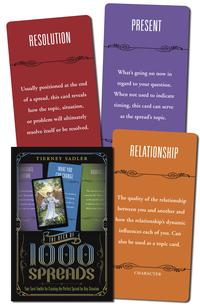Spreadcrafting
Gail Renfrow is a member of a local tarot group. She brought The Deck of a 1000 Spreads with her and wrote a review. We thought the review was so good that we asked her if we could share it. She very generously agreed! Here is it:
When I first saw Llewellyn’s new Tarot kit, The Deck of 1000 Spreads, my first thought was “This is genius! How has no one thought of this before?” As the moderator for Witch City’s Tarot study group, I know how difficult it can be when one first jumps into the world of Tarot. First you have to learn what the 78 cards represent, then what they represent when they’re reversed, and then you have to find and remember several spreads and understand how the cards interact in those spreads. And when none prove to be the perfect spread, you have to find a way to create your own spreads.
Though there are thousands of books helping learn the meanings of the Tarot Cards, and dozens with different spreads, I have never seen anything as interactively useful as The Deck of 1000 Spreads. The 59-card deck does not consist of oracle cards, but of the various positions that appear in most well-known tarot spreads. Each over-sized card includes the definition of the position and what it represents. There are green Topic cards (such as Problem, Romance, and Significator), purple Timing cards (such as What to Leave in the Past, Present, and Future Life), blue Influence cards (such as Hopes & Fears, What You Can’t Change, and Unconscious Desires), orange character cards (such as You, Partner, and Co-Workers), and red Outcome cards (such as Advice, Resolution, and Lesson). Also, like any good Tarot deck, there are also blank cards in each color that you can fashion into any type of position you like.
For the beginner Tarot student, they can use these cards initially to learn well-known spreads such as the Celtic Cross, Two Roads, or the various one- and three-card spreads that are out there. By pre-placing the oversized cards into the shape of the spreads, and then placing Tarot cards on top of the position, it provides a focus for what the cards signifies in those positions, and serves as reminder of what the position indicates (so you don’t have to keep poking your nose in the book wondering “what does that position mean again?”).
The kit proves to be more than just a learning tool for novice learners. The book that is included walks users through several ways of re-focusing old spreads and designing new ones. Everyone has run into a time when they focus on one question and get the answer to another. This is completely confusing for beginners and just as frustrating for more intermediate and adept learners. “Why is this spread about my health when I asked about my career? Should I have focused on the question more? Did I pick the right spread? Am I interpreting the cards right?”
The book suggests making changes, a few to the entire spread, to help the focus. To not unhinge the spread entirely, it suggests sticking to the color-coding. To update the Celtic Cross spread for a more romantic focus, you can exchange the green Situation topic card from the center to the green Romance topic card and change the orange Others character card to the orange Partner character card.
When I brought a general yet intricate spread to teach my cohorts for our February study group at Alchemy Arts, everyone seemed pretty disappointed that I hadn’t brought a romantic spread to celebrate Valentine’s Day. So I said, “Well, if that’s the way you feel, let’s make a new romantic spread!” Using the Romance, Situation, You, Partner, Pros, Cons, Positive Influences, and Negative Influences, I quickly dealt out a spread and let everyone try it out. It was surprisingly accurate, and everyone came away with good advice for whatever their romantic life entailed.
Though I had designed my spread rather randomly, the book provides several tips for designing your own through the color-coding of the deck. Some examples include using a green Topic card like Card of the Day or a red Outcome card like Advice a one-card spread, or three purple timing cards (Past, Present, Future) or three green Topic cards (Body, Mind, Spirit) for a three-spread card.
Of course, the book also gives you the option of throwing all caution to the wind and let the Higher Powers determine your spread by shuffling the position cards and laying them out as you intuit.
I’ve had a lot of fun with this kit, trying out all of the different suggestions and extracting great lessons from my Tarot deck that I hadn’t thought of before. This is a true gem for any Tarot student, novice and adept alike. It is easy to learn, easy to use, and fun for experimenting with and creating more valuable spreads.











Still experimenting with the deck. It’s an interesting solution to some problems.